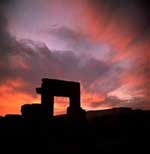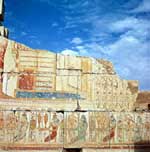|
Abydos
 Abydos, or Abjdu, lies in the eight nome of Upper Egypt, about
300 miles south of Cairo, on the western side of the Nile and
about 9.5 miles from the river. It spreads over 5 square miles
and contains archaeological remains from all periods of ancient
Egyptian history. It was significant in historical times as the
main cult center of Osiris, the lord of the netherworld. Abydos, or Abjdu, lies in the eight nome of Upper Egypt, about
300 miles south of Cairo, on the western side of the Nile and
about 9.5 miles from the river. It spreads over 5 square miles
and contains archaeological remains from all periods of ancient
Egyptian history. It was significant in historical times as the
main cult center of Osiris, the lord of the netherworld.
Abydos was the burial place for the first kings of a unified
Egypt. But it contains remains from earlier, in the Predynastic
period.
 The Predynasty/Early Dynastic cemetery is located in the low
desert. It consists of three parts: predynastic Cemetery U in
the north, Cemetery B in the middle with royal tombs from
Dynasty 0 and the early 1st Dynasty, and in the south the tomb
complexes of six kings and one queen from the 1st dynasty and
two kings from the 2nd dynasty. Most of the 1st dynasty tombs
show traces of immense fires. Many had also been plundered many
times. The Predynasty/Early Dynastic cemetery is located in the low
desert. It consists of three parts: predynastic Cemetery U in
the north, Cemetery B in the middle with royal tombs from
Dynasty 0 and the early 1st Dynasty, and in the south the tomb
complexes of six kings and one queen from the 1st dynasty and
two kings from the 2nd dynasty. Most of the 1st dynasty tombs
show traces of immense fires. Many had also been plundered many
times.
North Abydos contains an ancient settlement and also the remains
of a large stone temple from the 30th Dynasty, along with a
portal structure of Ramesses II, and a fairly recently
discovered temple built by Tuthmosis III. Most of the early town
lies beneath modern groundwater and the remains of later
settlements. Another temple, that of Khentyamentiu which was
later identified with Osiris as his temple, dates from the later
third millennium BCE.
 A residential and industrial section have also been found to the
southeast of those excavations, dating to the Old Kingdom and
First Intermediate Period. A number of mudbrick houses,
consisting of between 7 and 10 small rooms, courtyards and a
narrow street have been found. A workshop, the earliest and most
complete faience workshop in Egypt, was also uncovered, complete
with kilns. A residential and industrial section have also been found to the
southeast of those excavations, dating to the Old Kingdom and
First Intermediate Period. A number of mudbrick houses,
consisting of between 7 and 10 small rooms, courtyards and a
narrow street have been found. A workshop, the earliest and most
complete faience workshop in Egypt, was also uncovered, complete
with kilns.
 The tombs of the first kings of unified Egypt were deep
brick-lined structures topped with mounds of sand, later called mastabas, the Arabic word for bench, since their square or
rectangular shapes resembled benches. Later in the 1st Dynasty,
one structure was placed underground, supported by a retaining
wall, and the second mastaba was placed above ground directly
over the first, to protect the lower one. The tombs of the first kings of unified Egypt were deep
brick-lined structures topped with mounds of sand, later called mastabas, the Arabic word for bench, since their square or
rectangular shapes resembled benches. Later in the 1st Dynasty,
one structure was placed underground, supported by a retaining
wall, and the second mastaba was placed above ground directly
over the first, to protect the lower one.
The Northern cemetery was the principal burial ground for
non-royal individuals at Abydos during the Middle Kingdom, and
continued to be so used through the Greeco-Roman period. |